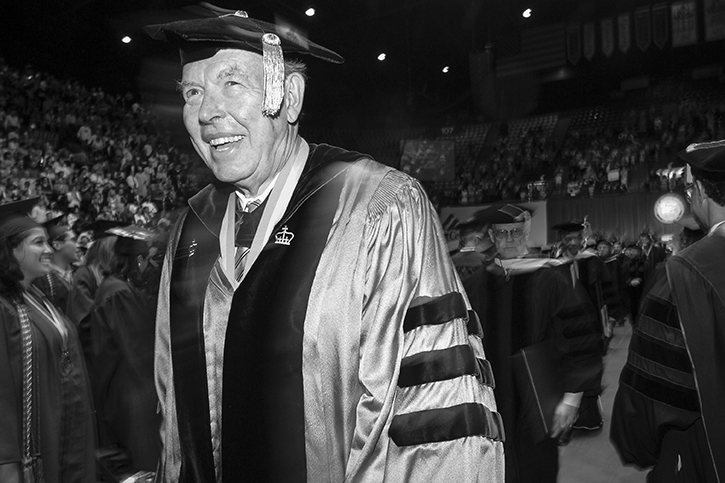
George Johnson at Mason's 2004 Commencement, where he received the Mason Medal. File photo by Evan Cantwell.
At a remembrance and celebration of former George Mason University President George W. Johnson on Monday, admirers recalled the university’s fourth and longest-serving president as an empowering visionary who guided George Mason from a regional school into a nationally recognized institution.
The Center for the Arts Concert Hall, one of Johnson’s signature projects, was a fitting venue for the event. Facilities increased by 20 buildings, and 3 million square feet, during Johnson’s 1978-96 tenure. Johnson died in May at 88.
While he was Mason’s president, the university’s enrollment more than doubled to 24,000 and degree programs grew from 56 to 110 (including the university’s first doctoral programs). Johnson worked closely with Northern Virginia political and business leaders to convince downstate legislators that this growing region of the state needed a major research university that would grow side by side with the region.
“We can become our region’s university, Virginia’s special university and a national university all at the same time,” Johnson said in a five-minute video at the ceremony, capturing his bold plan for Mason as an innovator, not an imitator.
By all accounts, the 6-foot-6 North Dakotan followed through on his grand vision. Among the schools and facilities that sprouted during Johnson’s tenure were the Volgenau School of Engineering, EagleBank Arena, the College of Visual and Performing Arts, Scalia Law School, the School for Conflict Analysis and Resolution, the Schar School of Policy and Government, Krasnow Institute for Advanced Studies, New Century College, the Honors College and the Johnson Center (named in his honor).
Johnson also started the Robinson Professors Program, Early Identification Program, and the Science and Technology and Arlington campuses. Mason won two Nobel Prizes in economics during his tenure.
“My task was not to envision the architecture of the shining city on the hill,” Johnson said in the video. “My job was to get us all to the hill.”
The ceremony also highlighted the more lighthearted side of Johnson. Burning Tree Club golfing friend Alan G. Kirk recalled former English professor Johnson as “a jolly good fellow” known as “Dr. J” around the club. Johnson liked to quote literary passages on the golf course and on occasion would request some T.S. Eliot from his pal Kirk.
The other speakers at the remembrance, all with Mason ties, also spoke of Johnson’s intellectualism, vision and the lasting impact he had on their lives, the university and Northern Virginia:
Clara Lovett, former Mason provost and president emerita, Northern Arizona University
“George Johnson was quintessentially an academic president. He was an intellectual in his own way. And therefore he was very respectful of academic traditions, including the way we had historically planned campuses. But he pushed all of us to look beyond, to establish new traditions, to realize that you can forge ahead, rethink the enterprise, without being unfaithful or disrespectful to what came before.”
John T. “Til” Hazel, former Mason rector
“When I think about George Johnson, three words come to mind – vision, courage and determination. George had the vision to see ahead what most people didn’t see. He had the courage to undertake the most difficult things and never waver. And he had the determination to stay with his activities until he reached the goal.”
Alexandra Kostovski, Johnson’s granddaughter and current Mason student
“It was a privilege to have grown up with a man of his character. George has impacted the woman I have become today, a woman who treats people with kindness no matter what background they’re from. I feel honored to be the granddaughter of a man who highly valued education. I carry him with me every day, and I’m often reminded by his love in [wife] Joanne and a strong resemblance in his son Garth. He may be out of sight, but he is surely never out of my mind.”
Carol Mattusch, Mason professor emerita
“Being hired at George Mason of course required a job description. But our jobs under George Johnson were never quite about the job description. They were about what we could do. ‘Ask for what you want,’ he said, and that is what he did as president…. He made this university what it is today. The faculty, the programs and the students are the results of his vision and his tenacity.”
Ángel Cabrera, Mason president
“George Mason University is such a gem in American higher education that together this community has built thanks to a very special man like George Johnson. We owe it to him, to his memory and to the whole community to make sure we preserve this jewel.”
